Reviving Parmegiani’s “Stries” (1980)
Translation of Historic Analogue Works Into the Digital Domain
Analysis of the Electronics and Technical Requirements
Unbeknownst to most, Bernard Parmegiani (1927–2013), the grand old man of French electroacoustic music, wrote more music for performers than Violostries (1964), for violin and tape. While Exercisme I (1986) can be found on the L’œuvre musicale en 12 CD box set, the epic 50-minute Stries (1980) has so far only partially been released on LP and has, until recently, not been played live for 30 years. Both these pieces were written for the three synthesizer players of the Paris-based electroacoustic trio TM+, Yann Geslin, Laurent Cuniot and Denis Dufour, founded at the INA/GRM.
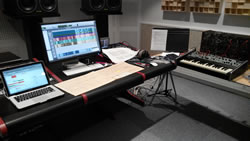
Over the span of the ensemble’s lifetime, TM+ used a range of different instruments — analogue synthesizers in the late 1970s and early digital synthesizers in the mid-1980s — and amassed a repertoire of about 40 compositions written especially for them. Other groups of that time who employed the same concept of live played electronics include, for example, the Ensemble d’Instruments Electroniques de l’Itinéraire (which included Tristan Murail and Claude Pavy), the Oeldorf Gruppe (with Peter Eötvös, Mesías Maiguashca and featuring Emmanuel Nunes), or the Canadian group CECG/GEC (Kevin Austin, Jean-François Denis and others). It is of note that most of the compositions written for or performed by these groups are not in the active repertoire of today.
Stries is a composition for tape and three synthesizers and the score makes numerous references to the instruments used by TM+ at that time: a Yamaha CS-40M (Geslin), a Synthi AKS (Cuniot) and a Roland System 100M Set D combined with the keyboard of the Roland System 100 (Dufour).
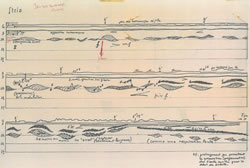
Fortunately, Yann Geslin, of the INA/GRM, took it upon himself to be some kind of archivist for the scores, and indeed the original score by Bernard Parmegiani, as well as for those of the instrumentalists that could be found. Also available in the GRM’s archives was the original analogue reel-to-reel tape for the piece, as well as the analogue 8-track recordings from the recording session. Armed with this material, the electronic music trio consisting of Colette Broeckaert, Martin Lorenz and Sebastian Berweck, together with Yann Geslin started to recreate the piece with the aim of bringing the piece back to the stage as well as producing generic scores that could help get the piece into the repertoire of many instrumentalists.
While the score by Parmegiani already had references to the instrument’s specifics, it was actually the annotations (Fig. 2) and patch diagrammes (Fig. 3) found in the performers’ scores that provided information on how to programme and play the patches.
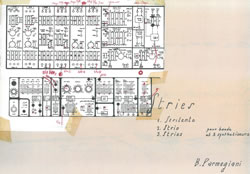
Although manuals for all the equipment required for this project can be found on the Internet, it is nevertheless necessary to recreate these patches on the original instruments, since no manual can completely convey the actual workings of the machines. Most manuals lack (to some degree) specific yet essential technical information (e.g., uni- or bipolarity of oscillator modulation inputs), but more importantly do not offer sufficient indications about the specific resulting sound of the instruments. The Roland’s 24 dB low-pass filter, for example, sounds much more like an 18 dB filter, and the actual effect of the high-pass filter on the actual sound has to be heard in order to be recreated.
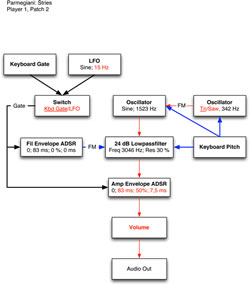
In the end, the instruments have to actually be understood in a much broader sense than reading a manual can convey. It was therefore necessary to get original models of the three synthesizers in a working state, which, considering their “vintage” status and the price tag associated with such a status, was not an easy endeavour. For example, in the first meeting the musicians had at the GRM, the Synthi AKS power cable was missing, the Yamaha CS-40M would not turn on and the Roland’s keyboard was absent. However, once the synthesizers were working it was possible to analyze the patches (Fig. 3) and carefully measure out all the frequencies, which on these old machines had to be done by ear. A seemingly complicated patch sheet for the Roland System-100M/System-100 combination often turned out being rather simple signal flows (Fig. 4), much simpler than, for example, many of today’s Max patches.
Analyzing the initial patch does not give much information though on how the patch is being played. Notes in the score such as these that can be seen in Figure 5 must be analyzed and put into perspective. In the end, large spreadsheets had to be built in which every change of every parameter that is played in the course of the piece was documented (Fig. 6).


As straightforward as this might look, it takes a lot of time to really understand the inner workings and peculiarities of each of the instruments in order to be able to recreate the sounds. Additionally, decisions had to be made about whether the limitations of the instruments were to be considered as “part” of the composition: was this a conscious decision made by the composer, or rather an unintentional and perhaps (at the time) unavoidable factor in composing for such instruments? An interesting example would be the ring modulator of the Synthi AKS, well known for its introduction of many additional sidebands (a.k.a. “leaking”): nowadays it is a question of interpretation whether the peculiar tonal character of the Synthi AKS’ ring modulator is actually pleasing or the undesired side effect of an unsatisfactory technical design. 1[1. It is interesting to note that Yann Geslin, one of the original players, liked the cleaner digital variant of the ring modulator much more, whereas the trio from Berlin preferred the sound of the Synthi AKS. However, since Bernard Parmegiani cannot give the “last word” on the matter, it will remain a topic of interpretation. A similar question arises with Tristan Murail’s two pieces for two Yamaha DX7 synthesizers, Vision de la cité interdite and Atlantys: Is a cleaner 16-bit version that lacks the hiss of the first generation of the DX7 preferable to a “retro” 12-bit version conveying the sound of the time?]
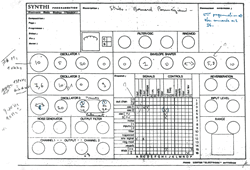
An even more obvious example showing such problems of interpretation is found in the rather crude way patches had to be “documented” using patch sheets (sometimes called dope sheets). In a hand-drawn annotation, a mark indicating, for example, 7.6 on Oscillator 2 (which goes from “0” to “10”) could result in anything between, for example, 124 and 169 Hz (Fig. 7). A similarly crude indication for the filter could result in a setting around 650 Hz when what was actually meant was an exact relationship of 1:4 between oscillator and filter, and thereby an emphasis of the oscillator’s fourth partial.
After analyzing the patches, they were recreated using a Clavia Nord G2 synthesizer, a virtual analogue modular synthesizer environment that is well suited to rapid prototyping (Fig. 8). The process of recreating the patches on another system also helped to clarify the structure of the patches and check on some of the minor things that could easily be overlooked, like the polarity of LFO modulations or peculiarities in the original synthesizer’s LFO waveforms. The recreation of the patches thus serves as a necessary proofing tool.

To our delight, most of the patches were able to be seamlessly translated into the new environment and sound “the same” as the original. The discrepancies we experienced are perhaps not so significant if we consider the idea that we were indeed using two different instruments and that the same violin piece played by the same musician on different instruments would never sound identical either. In the end, most of the sounds of the two completely different synthesizers were found to be so close to each other that without any alteration, the direct “translation” of the patches would be coloured much more by the choice of loudspeakers, interfaces and the differing acoustics of different concert halls than by the different instruments themselves. 2[2. On another note, it must be mentioned that the original instruments would sound different not only due to variations in the single modules but also simply because of the different revisions of the instruments (e.g., Arp Odyssey rev. 1–3), not to mention the state of their maintenance and the climate in the room — in the end, the situation is strikingly comparable to that of acoustic instruments such as violins or pianos.] Of the 40 patches recreated, only two sounded notably different and had to be recreated using different modules, and this could still have been due to insufficient analysis of the original instruments and their workings. In the end, one of the most important results of this endeavour is probably the conclusion that analyzing the signal flow of an older analogue machine and directly recreating the patches on a digital synthesizer conveys convincing results, and is more than just a possibility.
Comparison with Analogue Modules
Having recreated the patches on a digital synthesizer, we wanted to find out if they would sound indeed better, or at least noticeably preferable, on analogue synthesizers. One of the difficulties here is the fact that it takes a lot of hardware to actually be able to recreate the sound of three different historic synthesizers on more recent instruments. For example, the contemporary variants of non-modular analogue synthesizers by Dave Smith Instruments don’t feature all the modules necessary to recreate the Roland System-100M/System-100 combination with its three low-pass filters or the Yamaha CS-40M combined five oscillators. Or they don’t feature as flexible routing possibilities as the Synthi AKS. The only possibility to recreate these patches without the original synthesizers in the analogue realm would require a massive modular setup with dozens of modules. However, we recreated some of the simpler patches using a mix of components, notably two DSI Evolvers, a Pittsburgh Foundation 3 modular setup and an array of several other analogue modules, namely the Frequency Central System X Envelope, Manhattan Analog Discrete SVVCF, and Endorphin.es Furthrrrr Generator and Terminal. The sonic differences between the different modules did not create qualitative differences that could easily be deemed “better” or “worse” but are simply “different” from machine to machine.
As a matter of fact, the whole process can, again, very well be compared to the selection of grand pianos available in large concert halls. A pianist will choose one instrument over another based on the compositions that are going to be played on the programme as well as on personal preferences such as touch, tone colour and general acquaintance with the instruments. In the end it would boil down to personal preference and two different pianists are quite likely to choose different instruments for the performance of the same works.
Returning to the example of two violins, however, a Stradivari must be played differently than a Guarneri; attempting to get the typical Stradivari sound out of a Guarneri can only result in a poor imitation of a Stradivari, without bringing out the qualities of a Guarneri. Similarly, the simple recreation of a patch on another instrument can at best be equal to the sound of the original, but will most likely be of a lesser quality. It is therefore necessary to apply a strategy that does not just try to mimic the signal flow of the original patch but indeed takes into consideration the strengths and weaknesses of the new instrument and attempts to recreate the sound as it was intended. The end result will be an interpretation of the patch sheet — similar to the interpretation of a musical score.
Considering the external factors of any concert situation — mainly the acoustics of the concert hall, the colouring of the tone by different loudspeakers and a performer’s ability to adapt to these circumstances by changing their playing style — the tonal differences of the sound modules themselves proved to be of lesser importance than more mundane considerations such as portability, reliability, replaceability and programmability, not to mention the ability to store and recall patches with just the push of a button.
From the standpoint of an interpreter who wants to play a variety of compositions originally played on a whole array of vintage synthesizers, the digital domain offers many conveniences without lessening the tonal qualities in the interpretation of historical works 3[3. An in-depth discussion by Rob Hordijk on the tonal differences between many digital instruments and analogue machines can be found in his 25 July 2005 post on electro-music.com, “Spectrum Tilting.” Ironically, the same overload of high frequencies can be found in digital recreations of digital synths as well, for example in the otherwise very close-sounding software synthesizer Dexed, modelled after the Yamaha DX7.]. It must, however, be conceded that using vintage gear would seem to have, for some, a bigger “sex appeal” than current machinery. The question of whether this is a valid point of discussion in relation to musical performance we will leave to other authors to discuss.
Generating Generic Scores
As for the recreation of Parmegiani, the material is now in such a state that it should be possible for other interpreters to take on the piece without the extremely time-consuming challenge of having to analyze the original instruments and patches. The new edition of the performance instructions and materials now consists of:
- Signal flow;
- Description of patch, signal flow chart and playing styles;
- Translation of comments in the score from French to English, as well as from the instrument-specific domain into the generic domain (e.g., from “LFO = 3” to “LFO = 3.24 Hz”);
- Sound examples.
As with the above example of recreating the patches in order to check the accuracy of the analysis of the signal path, it was again necessary to have the signal flow charts proofread by another person trying to recreate the patches. Again, a choice must be made as to what information must be conveyed and what should be left to interpretation. An overly bloated patch diagramme giving the most precise directions like accelerating an LFO from 1.23 Hz to 5.57 Hz in 3.5 seconds will not result in a musical application of said LFO but in a performer looking at a screen to check the accuracy of numbers instead of “playing” the LFO. 5[5. The same would happen with the instruction to “Change MIDI CC 7 (volume) from 60 to 84” instead of using known musical parameters like “crescendo mp to mf”.]
A complete documentation of the patch in Figure 4 would require the following information to make it feasible for any performer to prepare and perform the work:
- General indications;
- Sources;
- Reference to the patch in the score and in the material;
- A general description of the signal flow;
- The modules required to recreate the patch;
- A listing of the parameters that are being played (this is necessary to programme the controllers to play the patch);
- Translation of the notes in the score.
An example of complete documentation of patch 2 for Player 1 in Bernard Parmegiani’s Stries is found in the next section.
Example of Proper Technical Documentation
Player 1 (In Score Indicated as SR, Synthétiseur Roland)
Indications in Hertz (Hz) always refer to a basic setting of MIDI Note 69 (concert pitch A4 = 440 Hz) for oscillators and filters which employ keyboard tracking. A specification of “99 Hz Sine Oscillator” therefore means that the oscillator will have a pitch of 99 Hz when triggered by MIDI Note 69.
Keyboard pitch tracking is 100% unless noted otherwise.
Due to the nature of the analogue instruments used, all indications are only approximate. Initial settings for most modules are provided, however, it is not possible to simply punch in the data and have everything work. Some things, for example the amount of FM from one oscillator to another, will have to be set by ear, which is why references to the sounds of the original vinyl release are given.
Sources
Original score for Stries (1980, unpublished) by Bernard Parmegiani.
Score for Stries annotated by Denis Dufour.
Another annotated score with the indication “Stries (80)” in the top left corner of page 1 of part 3 (Stries).
An 8-track recording of the original release.
2. Strio — Patch 1 (0:00)
The original patch 1A/1B is used in the second section, Strio. Note that 1B is the same as 1A but has already preparations for 3. Stries, the third and final section in Stries.
Description of the Patch
The right channel of the original tape is split into three signal paths:
- The tape is ring-modulated with a sine wave. The signal goes then into an ADSR envelope; the envelope is gated by the keyboard.
- 50% of the original tape signal goes into the above described envelope.
- The tape signal also goes directly into a 24 dB low-pass filter (NB: it sounds more like 18 dB to me [Berweck]), which is mixed with the above post-envelope signal right before the output. The low-pass filter is completely closed at the beginning of the piece.
Modules Required
- Keyboard
- Audio input
- Oscillator: Sine
- Ring Modulator
- 2 Mixers
- ADSR Envelope
- 24 dB Low-pass filter (with resonance?)
- Audio output
- Volume control
Parameters Played
- Frequency of sine wave oscillator manually and via keyboard tracking (100%)
- Frequency of low-pass filter
- Gate of the envelope with the keyboard
- Mix of signal paths 1 and 2
- Mix of signal paths 1/2 and 3
- Overall volume
Performance and Further Remarks
The following timing indications (translated from the French original) have been made in comparison with the original recording by TM+.
0:00 — Opening and closing of the low-pass filter and change of volume / Filtrage bande direct [dur. ca. 0:18].
1:00 — A larger crescendo marks the entrance of Player 3 / SY: Yann [1:06 in the recording].
2:40 — Adding attacks of ring-modulated tape with the keyboard / (Encrustations) de la modulation [2:49 in the recording].
[3:22 — A change of timbre is triggered by a change in timbre on the tape].
4:00 — Longer sounds of ring-modulated tape [4:09 in the recording].
[From 4:09 and especially from 4:29 on the original recording there are prominent attacks of ring-modulated tape.]
5:10 — Less and less of the original tape, only low frequencies / De moins en moins de “direct” (Laisser seulement les graves).
6:15 — Glissando is generated by lowering the frequency of the sine oscillator, “like slow breathing” / (Comme une respiration lente) [in the recording only from 6:43, probably refers to 6:39 marking].
Conclusion
With the new material created by Colette Broeckaert, Martin Lorenz, Sebastian Berweck and Yann Geslin, this major composition has been brought back to the stage with great success after lying dormant for 30 years. Considering the amount of works only the above-cited ensembles produced in the 1980s, we can surmise that there is still a large body of electroacoustic compositions waiting to be produced again.
As far as the re-creation of instrument-dependent electroacoustic compositions goes, the amount of time that went into Parmegiani’s Stries, not to mention similar efforts in the recent editions of Luigi Nono’s Das atmende Klarsein and Altra voce by Luciano Berio, is exceptional and it is unlikely that this amount of effort will be made to resurrect the majority of extant pieces. It can therefore not be stressed enough that the most time-consuming process lies in the analysis of the patches and the score and not so much with the re-creation of the technology. The problems inherent in the re-creation of electroacoustic music are thus much less a problem of archiving, as is commonly argued, but much more a problem of generic notation, which has thus far proven to be improperly and insufficiently employed.
Social top